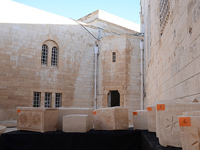Linda Gradstein/The Media Line
It sounds like the plot of a thriller. Two antiquities thieves, carrying their stolen loot, meet a potential buyer at an Israeli checkpoint in the dead of night. The police arrest the thieves and the dealers, recovering the priceless antiquities.
This scenario is exactly what happened last weekend at the Hizme checkpoint north Jerusalem, separating the capital from the West Bank; an area that serves as a crossing point between Jewish Israel and the Palestinian territories. Israeli police, on a routine patrol around 12:20 a.m., grew suspicious of the group of four men — two Arabs and two Jews — gathered near 11 stone ossuaries, stone boxes used in Jewish burials during the Second Temple Period some 2000 years ago.
They detained the men, who have denied any wrongdoing. The four are being held in jail, while an indictment is being prepared.
“The arrests came after an undercover operation that went on for several weeks,” Jerusalem police spokesman Mickey Rosenfeld told The Media Line. “The suspects were from Tel Aviv, east Jerusalem, and a village near Bethlehem; and were arrested when they tried to sell to a Jewish dealer.”
Besides being charged with trafficking in stolen antiquities, the Palestinian has been charged with illegal entry into Israel. All Palestinians need special permits to enter Israel. The man from east Jerusalem was the driver.

Israeli archaeologists say that had the sale gone through, valuable archaeological material would have been lost.
“Each ossuary has a name on it so each one is unique,” Dr. Eitan Klein, the deputy director of the Unit for the Prevention of Antiquities Theft told The Media Line. “We found one name in Hebrew, Ralfin, that we don’t know of from anywhere else. If that had been stolen, we would have never known about this name.”
Ossuaries are used to store bones in burial caves. During the Second Temple Period (530 BCE – 70 CE), which also includes the time of Jesus, Jews would bury their dead in niches built into the walls of caves. After a year, they would return to the cave and store the bones in stone boxes called ossuaries. The ossuaries would often be engraved with the person’s name. In some cases, the bones of two people, such as a husband and wife, would be put in the same ossuary.
Klein, of Israel’s Antiquities Authority, says they have about one thousand ossuaries in their collection. The 11 found in this raid have some of the common motifs found on other ossuaries. Since Judaism frowns on using humans in art, the ossuaries are decorated with flowers and geometric shapes.
The Antiquities Authority put the ossuaries on display at the Rockefeller Museum in east Jerusalem. Two of the recovered ossuaries are tiny and must have been used for babies. Several were half-filled with bones, including a piece of what was clearly a skull.
The bones will be transferred to Jerusalem’s burial society, where they will be buried in accordance with Jewish law.
Israel is the only country in the Middle East where selling antiquities is legal, says police spokesman Rosenfeld, although the profession is regulated by law. That means that thieves often try to smuggle antiquities from Egypt,
Jordan and the West Bank into Israel to sell them. The illegal trafficking often runs in families, explained Klein.
“It is a profession that is often passed on from father to son, and we often arrest the same people over and over,” he said.
The mandated sentence for the crime is up to three years in jail, although judges usually give sentences of seven or eight months. He said that supervisors for the authority find as many as 300 illegal excavations each year.
“That means that almost every day of the year someone is digging illegally,” he said.
Between 50 and 60 “cells” are broken up each year, meaning more than 100 people are arrested annually.
“These are very professional cells, who are doing it over and over as a professional career,” he said. “I think the sentences the court gives them much should be longer to try to stop this trafficking completely.”